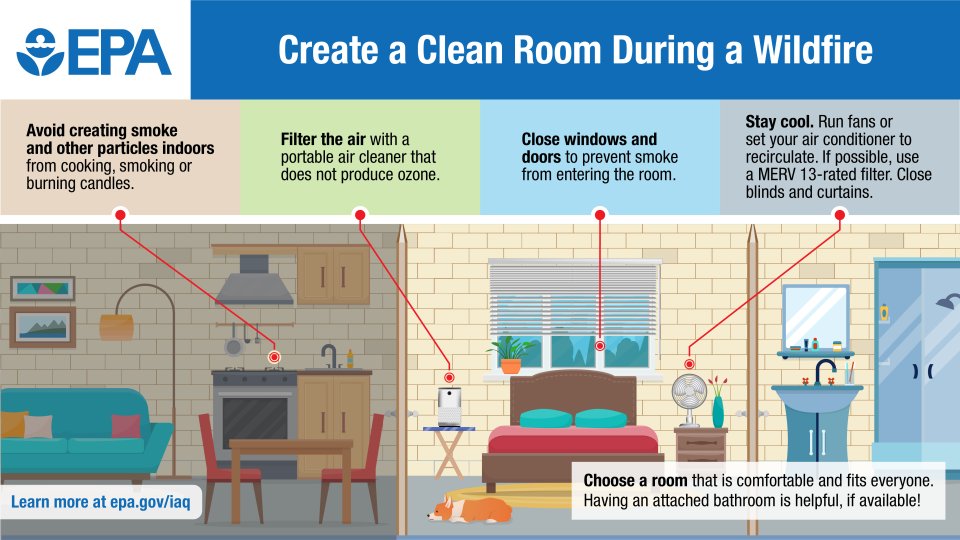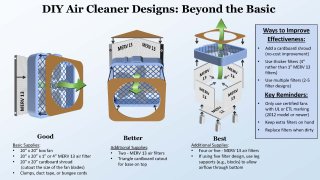Create a Clean Room to Protect Indoor Air Quality During a Wildfire

Available in these languages:
Wildfire Smoke and Indoor Air Quality: How to Set Up a Clean Room at Home
- Know how you will get emergency alerts and health warnings.
- Know your evacuation routes.
- Gather emergency supplies, including N95 respirator masks.
- Have at least a 5-day supply of food and medication on hand.
- Talk to your health care provider about what to do if you have heart or lung disease. If you have asthma, make sure you have an asthma action plan.
- Know how you will communicate with your family or other members of your household.
- What is a Clean Room?
- Why Create a Clean Room?
- Who Needs a Clean Room?
- How Do I Set Up a Clean Room at Home?
- Wildfires and Indoor Air Quality
- Wildfires and Indoor Air Quality in Schools and Commercial Buildings
What is a Clean Room?
A clean room is a room that is set up to keep levels of smoke and other particles as low as possible during wildfire smoke events. A clean room should be free from activities that create particles such as cooking or smoking, and the doors and windows should be kept closed to prevent smoke from getting in. A clean room can also contain a portable air cleaner that makes the air in the room cleaner than the rest of the home.
The How to Create a Clean Room at Home fact sheet provides more information about setting up a clean room.
Why Create a Clean Room?
If there is an active fire in your area, or if the Air Quality Index indicates smoke levels are unhealthy and forecasted to remain there, local authorities may advise you to stay indoors or create a clean room. Spending time in a clean room at home can help reduce your exposure to smoke while staying indoors.
Conditions can change quickly, so you should always be prepared to evacuate if necessary. Follow your local news, the AirNow website, or your state air quality website for up-to-date information.
Who Needs a Clean Room?
As long as it is safe to stay indoors at home, anyone can benefit from spending time in a clean room during a wildfire smoke event. It may be most helpful for people who are at greater risk from the effects of smoke such as children, older adults, and people with heart disease or breathing problems. If you have heart or lung disease, including asthma, check with your health care provider about what to do during smoke events.
Learn more about the health effects of wildfire smoke.
If you can’t stay cool at home, the electricity goes out, or too much smoke is still getting in your home, it may be best to seek shelter elsewhere.
You may be able to:
- Stay with friends or family who are not affected by the smoke.
- Go to a public cleaner air shelter.
- Seek relief from the smoke in a large commercial building with air conditioning and good air filtration, like a shopping mall.
How Do I Set Up a Clean Room at Home?
- Choose a room. It should be big enough to fit everyone in your household and comfortable to spend time in. A bedroom with an attached bathroom, for example, is a good choice because you can close it off from the rest of the house and keep the door closed for long periods of time.
- Prevent smoke from entering the room. Close all windows and doors in the room, but don’t do anything that makes it hard to get out. If there is an exhaust fan or range hood in the clean room space, only use it for short periods because it can bring more smoke inside from elsewhere in the house.
- Stay cool. Run fans, window air conditioners, or central air conditioning. If your HVAC system or window air conditioner has a fresh air option (meaning it pulls in air from the outside), turn it off, close the intake, or set the system to "recirculate" mode. If you have an evaporative cooler and can safely access it, completely cover the outside air intakes with 4-inch-thick high-efficiency (MERV 13) furnace filters or use the cooler sparingly. Use portable air conditioners with a single hose sparingly in smoky conditions. Using these devices can bring more smoke inside from elsewhere in the house. Learn more about how to Protect Yourself from Smoke and Extreme Heat.
-
DIY Air Cleaner to Reduce Wildfire Smoke Indoors Infographic (PDF) - click image to view full-sized If portable air cleaners are not available or affordable for you, you may choose to use a do-it-yourself (DIY) air cleaner. DIY air cleaners are made by attaching one or more furnace filters to a box fan with tape, brackets, or a bungee cord, and can serve as a temporary alternative to commercial air cleaners.
EPA recommends using DIY air cleaners only when products of known performance (such as commercially available portable air cleaners) are not available or affordable. DIY air cleaners are not recommended as a permanent alternative to these products. Several studies indicate that well-built DIY air cleaners can perform similarly to commercial portable air cleaners in reducing airborne particles such as those in wildfire smoke. However, their performance depends on their design and how well they are put together. Each DIY air cleaner may perform differently, even after reassembling the same unit when changing filters. On the other hand, commercial air cleaners are more standardized from unit to unit, so performance testing of these products is more reliable.
If you have central HVAC, you can also install a high-efficiency filter (MERV 13 or higher) in the system to increase air filtration. Run the system’s fan as often as possible by setting the fan to "On" instead of "Auto" to get the most out of the filter. You may need to consult a professional HVAC technician to determine if a MERV 13 or higher rated filter is compatible with your system.
During periods of heavy smoke, plan to replace the filter in your air cleaner or HVAC system more often than recommended by the manufacturer. If you notice that filters appear heavily soiled when you replace them, you should consider changing them more frequently.
Tips - If You Choose to Use a DIY Air Cleaner
There are many ways to put together a DIY air cleaner. Some common designs are to place one filter flat against the fan, two filters taped with cardboard to form a triangle against the fan, or four or five filters taped against the fan to form a cube. In general, DIY air cleaner designs that use more filters are more effective. Using thicker filters (2-4" rather than 1" deep) or covering the outside corners of the front of the box fan (sometimes called a shroud) can also improve performance.
To maximize filtration, choose a high-efficiency filter, preferably rated Minimum Efficiency Reporting Value (MERV) 13 or higher, that is the same size and shape as the fan. Align the arrows on the filter with the direction of air flow through the fan. Try to get a good seal between the fan and filter. Run the DIY air cleaner as often as possible on the highest fan speed.
For more information see the infographic above and/or view these tutorial videos:
- One filter flat against the fan (from the Washington Department of Ecology)
- Two filters taped with cardboard to form a triangle against the fan (from the Confederated Tribes of the Colville Reservation)
If you use a DIY air cleaner, follow these safety tips:
- Use a newer model box fan (2012 or later) and look for one with a UL (Underwriters Laboratory) or ETL (Intertek) safety marking. These newer models have added safety features. Fans built before 2012 may pose fire risks. If you must use a fan built before 2012, do not leave it unattended or use it while sleeping.
- Follow the box fan manufacturer’s instructions, such as: do not leave children unattended when the fan is in use; do not use an extension cord; do not use a damaged or malfunctioning fan; and ensure that there are working smoke detectors throughout the home.
- Have extra filters on hand and change the filter when it appears dirty or starts to release smoke odors. During smoke events, filters may need to be changed every few weeks or days.
See the Indoor Air Filtration fact sheet and EPA’s Guide to Air Cleaners in the Home for more information. EPA is also conducting Research on DIY Air Cleaners to Reduce Wildfire Smoke Indoors; the study webpage provides more information about this filtration option.
- Avoid activities that create smoke or other particles indoors, including:
- Smoking and vaping.
- Using gas, propane or wood-burning stoves and furnaces.
- Spraying aerosol products, such as cleaners or air fresheners.
- Frying or broiling food.
- Burning candles or incense.
- Vacuuming, unless you use a vacuum with a HEPA filter.
Dust or mop surfaces in the clean room with a damp cloth as needed to keep settled particles from getting back into the air.
Learn more about fine particles in indoor air.
- Spend as much time as possible in the clean room to get the most benefit from it. Avoid exercising while in the clean room to help reduce exposure to any particles that may enter the room. When the air quality improves, even temporarily, air out the clean room by opening windows or the fresh air intake on your HVAC system and run the exhaust fans in the kitchen and bathrooms to freshen the air.


